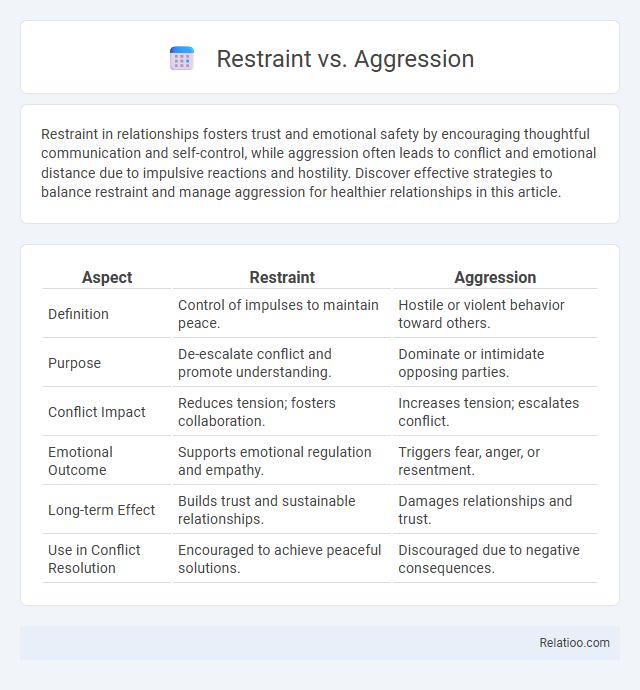Restraint in relationships fosters trust and emotional safety by encouraging thoughtful communication and self-control, while aggression often leads to conflict and emotional distance due to impulsive reactions and hostility. Discover effective strategies to balance restraint and manage aggression for healthier relationships in this article.
Table of Comparison
| Aspect | Restraint | Aggression |
|---|---|---|
| Definition | Control of impulses to maintain peace. | Hostile or violent behavior toward others. |
| Purpose | De-escalate conflict and promote understanding. | Dominate or intimidate opposing parties. |
| Conflict Impact | Reduces tension; fosters collaboration. | Increases tension; escalates conflict. |
| Emotional Outcome | Supports emotional regulation and empathy. | Triggers fear, anger, or resentment. |
| Long-term Effect | Builds trust and sustainable relationships. | Damages relationships and trust. |
| Use in Conflict Resolution | Encouraged to achieve peaceful solutions. | Discouraged due to negative consequences. |
Understanding Restraint and Aggression
Understanding restraint involves recognizing controlled self-discipline to manage impulses and emotions, promoting thoughtful decision-making and conflict resolution. Aggression is characterized by hostile or violent behavior aimed at asserting dominance or responding to perceived threats, often leading to escalated conflicts. Differentiating between restraint and aggression is crucial for cultivating emotional intelligence and fostering peaceful interpersonal interactions.
Defining the Spectrum: Restraint to Aggression
The spectrum from restraint to aggression defines a range of behavioral responses where restraint involves controlled, deliberate actions to manage impulses, while aggression represents uncontrolled, hostile behaviors aimed at asserting dominance or defense. Understanding this continuum helps you recognize how situational triggers shift responses from calm self-regulation to potential conflict escalation. Effective conflict resolution requires balancing restraint to prevent aggression and maintaining assertiveness without crossing into harmful behavior.
Psychological Roots of Restraint
Psychological roots of restraint are deeply embedded in self-regulation mechanisms, where the prefrontal cortex controls impulses and emotional responses to prevent aggressive behavior. Restraint involves cognitive processes such as delayed gratification and executive function, enabling individuals to manage anger and avoid conflict. Understanding these neural and psychological frameworks highlights how restraint serves as a critical adaptive strategy for social cohesion and personal well-being.
Causes and Triggers of Aggressive Behavior
Aggressive behavior often stems from frustration, perceived threats, or unmet needs, triggering a fight-or-flight response in your brain's amygdala. Environmental factors such as stress, past trauma, and social influences can significantly increase the likelihood of aggression, while poor emotional regulation or lack of coping skills exacerbate the reaction. Understanding these causes is crucial to managing aggression effectively and fostering restraint.
Social and Cultural Influences on Responses
Social and cultural influences significantly shape individuals' responses to restraint and aggression, dictating acceptable behaviors within different communities. Collectivist societies often emphasize restraint and conflict avoidance, promoting social harmony over overt aggression, while individualistic cultures may tolerate or even valorize assertive behavior as a sign of personal strength. These cultural norms influence not only individual emotional regulation but also societal responses to aggression, affecting legal systems, social appraisals, and interpersonal dynamics.
Benefits of Practicing Restraint
Practicing restraint enhances emotional regulation by reducing impulsive reactions and promoting thoughtful decision-making. It fosters healthier interpersonal relationships through improved communication and conflict resolution skills. Restraint also contributes to personal growth by encouraging self-discipline and resilience in challenging situations.
Risks and Consequences of Aggression
Aggression in conflict situations significantly increases the risk of physical injury, psychological trauma, and escalation of violence, potentially leading to legal consequences and damaged relationships. Unlike restraint, which promotes de-escalation and safety, aggression often results in loss of control, increased hostility, and long-term negative impacts on mental health. Understanding the dangers associated with aggression emphasizes the importance of employing restraint techniques to minimize harm and maintain constructive communication.
Strategies to Balance Restraint and Assertiveness
Balancing restraint and assertiveness requires employing strategies such as clear communication, setting firm boundaries, and recognizing emotional triggers to manage responses effectively. You can enhance interpersonal relationships by practicing self-awareness and maintaining a calm demeanor while expressing your needs confidently without resorting to aggression. Developing these skills supports constructive dialogue and helps prevent conflicts from escalating.
Real-Life Scenarios: Restraint vs Aggression
In real-life scenarios, restraint often prevents conflicts from escalating by promoting calm decision-making and emotional control, whereas aggression can lead to heightened tension, violence, and damaged relationships. Your ability to exercise restraint in high-pressure environments can improve communication, conflict resolution, and overall outcomes. Understanding the balance between restraint and aggression is crucial for personal safety and effective problem-solving in social or professional settings.
Fostering Healthy Interpersonal Interactions
Effective restraint involves controlling impulses to prevent aggression, which is essential for fostering healthy interpersonal interactions. Aggression often damages trust and communication, while practicing restraint promotes empathy, respect, and mutual understanding in relationships. You can enhance your social connections by consciously choosing restraint to navigate conflicts and maintain emotional balance.

Infographic: Restraint vs Aggression
 relatioo.com
relatioo.com